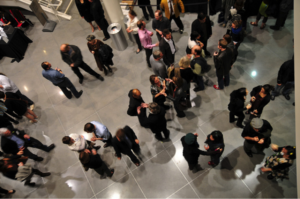“People from different vantage points are going to see different changes, and they’re going to see different opportunities,” Katy Bourgeois says.
 When it comes to community-based mental health projects, a mutual desire to collaborate doesn’t necessarily promise a job well done. Even though an increase in vocal diversity is, an advantage of cooperative efforts, misguided execution risks creating more discord than harmony between potential collaborators.
When it comes to community-based mental health projects, a mutual desire to collaborate doesn’t necessarily promise a job well done. Even though an increase in vocal diversity is, an advantage of cooperative efforts, misguided execution risks creating more discord than harmony between potential collaborators.
With the rise of collaborative philanthropy comes the urge to take a step back and determine what it is, exactly, that makes a collaboration effective. Here to educate us on the complexities of collaborative work are Katy Bourgeois, senior consultant at Mission Capital, and Tammy Heinz, program officer and consumer & family liaison at the Hogg Foundation.
Negotiating Power and Empowerment
When evaluating the success of a given collaboration, Bourgeois focuses on the presence of five core elements: shared goals, stakeholder engagement, ongoing evaluation practices, identifiable impacts and purposeful plans of action.
“There really needs to be an intentional, guided process,” Bourgeois says. “Some organization, or some individual, needs to own responsibility for forming the foundation and keeping the thing moving forward.”
Keeping the conversation inclusive and balanced, Heinz adds, also increases the efficacy of collaborative work. What’s needed is a “cross-section of people from the community” enjoining the resources and efforts of powerful institutions to the voices of historically marginalized populations.
“If you have it weighed too heavily on either side, then you don’t have a goal that comes out that actually works for all of the community,” Heinz says. “Really thinking it through—who are those people, and how we make sure they get to the table—is an extremely important piece.”
Collaborations addressing mental health at the community level have a mandate to accommodate openness, vulnerability and authentic listening in the dialogues they conduct between partners and the general public.
“When people feel heard, and when people feel understood,” Heinz says, “there’s a natural increase in their positive mental health, and an actual increase in the way they feel about their well-being. Just by pulling people together, just by having these groups come together in the right way—it can increase the community’s mental health.”
A Matter of the Mind, Heart and Will
Sometimes bringing stakeholders to the table is easier than getting them to stay. According to Bourgeois, this is where the “give-get proposition” can come in handy. “There’s a different give that each organization or individual provides in a collaborative effort,” she says. “But for a person to continue participating, they need to understand what they’re going to get out of it, too.”
Going back to Bourgeois’ measures of collaborative success, one thing that collaborators should expect to “get” when they contribute time and resources is actual results. “There has to be a balance between action and planning,” Heinz says. “Because if people think that you’re not actually going to do anything, they’re not going to come.”
Adopting a systems leadership approach, as opposed to organizational leadership, might help collaborations maintain the full scope of their operations without losing the ability to accomplish short-term goals. “We need to be able to look past the problems and really look to the vision of what we can accomplish together,” Bourgeois says, “and live in that tension between reality and what that vision could be.”
Bourgeois cites three principles for systems leadership that authors Otto Scharmer and Katrin Kaufer define in the book Leading from the Emerging Future: opening the mind, opening the heart and opening the will. The general need to think broader, Heinz says, influenced the Hogg Foundation’s decision to shift its strategic direction.
“The vision is we want a community to create the vision,” she says. “We’re trying to allow ourselves to sit in a place where we don’t have all the answers, and we want to learn alongside the people we’re working with.”
Learn more about our podcast and check out other episodes!
